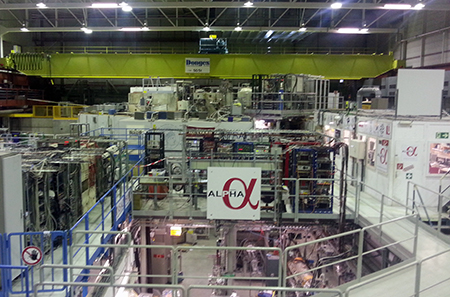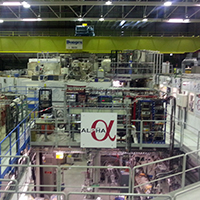 The Silicon Vertex Detector, a crucial component of the ALPHA experiment at CERN, was designed and built within the University
The Silicon Vertex Detector, a crucial component of the ALPHA experiment at CERN, was designed and built within the University
In a paper published in the journal Nature Communications, scientists report that for first time they have taken a precise measurement of the electric charge of anti-hydrogen atoms, helping understanding of the matter-antimatter asymmetry, one of the greatest challenges in physics.
The finding was made by the ALPHA experiment at CERN, where a crucial component, the Silicon Vertex Detector, was designed and built within the University of Liverpool’s Department of Physics.
How antimatter plasmas evolve
The detector can see inside the ALPHA atom trap where the anti-hydrogen is captured and provides information about how the antimatter plasmas evolve while the experiment is running.
Most importantly, it provides timing and spatial information of single atom annihilations inside the experiment.
Professor Paul Nolan, the Liverpool project leader said: “This is the first time neutral antimatter’s electrical properties have been precisely measured. We are looking forward to August 2014 when the anti-proton decelerator physics programme resumes and we can continue to study the secrets of anti-hydrogen.”
It is known, however, that matter and antimatter are not exact, so it is important to measure the properties of antimatter to great precision: the principle goal of CERN’s anti-proton decelerator experiments.
ALPHA achieves this by using a complex system of particle traps that allow anti-hydrogen atoms to be produced and stored for long enough periods to study in detail.
Understanding matter antimatter asymmetry is one of the greatest challenges in physics today. Any detectable difference between matter and antimatter could help solve the mystery and open a window to new physics.
Dr Petteri Pusa who is in charge of Liverpool ALPHA operations at CERN said: “We live in exiting times for ALPHA, the apparatus is currently being upgraded to allow laser access for future precision spectroscopic measurements.”
Tantalising insight
Joseph McKenna who is in the final stage of his PhD thesis on the ALPHA experiment said: “We are currently making preparations to re-install the Silicon Vertex Detector around the ALPHA neutral atom trap.
“ALPHA offers a tantalising insight to the world of antimatter, operating in one of the most interesting facilities in physics.”
UK funding of the ALPHA project has come largely from The Engineering and Physical Sciences Research Council (EPSRC) and supports teams from the Universities of Swansea, Liverpool and Manchester. The Science and Technology Facilities Council (STFC) co-ordinates and manages the UK’s involvement with CERN.
